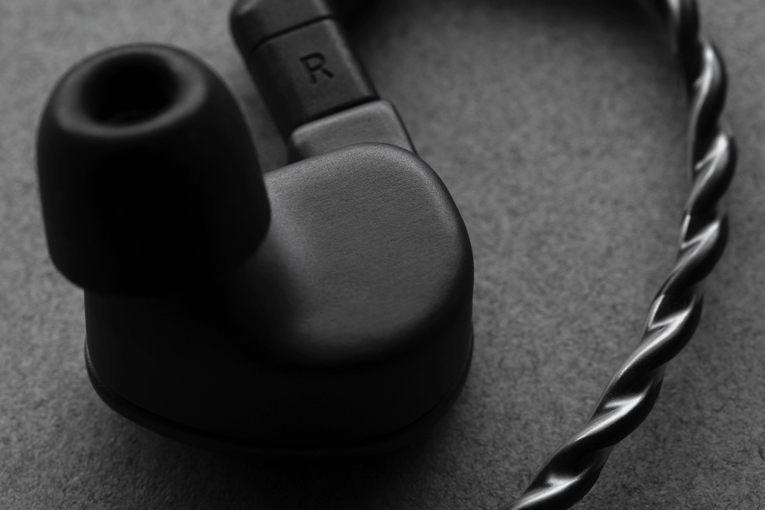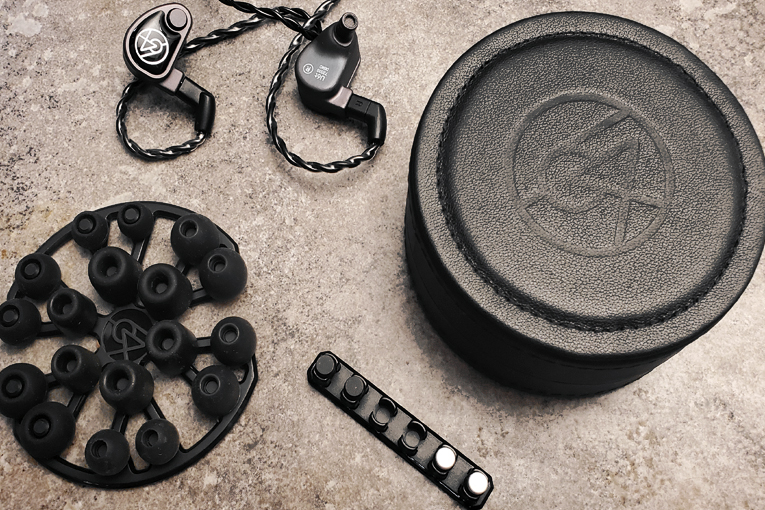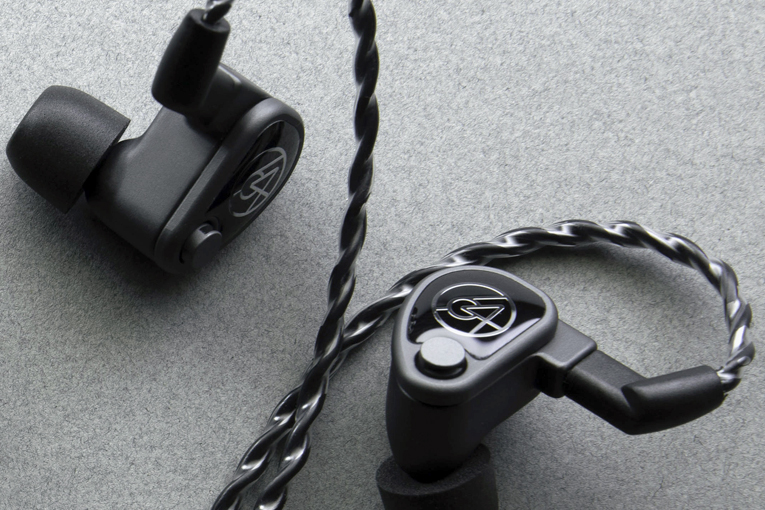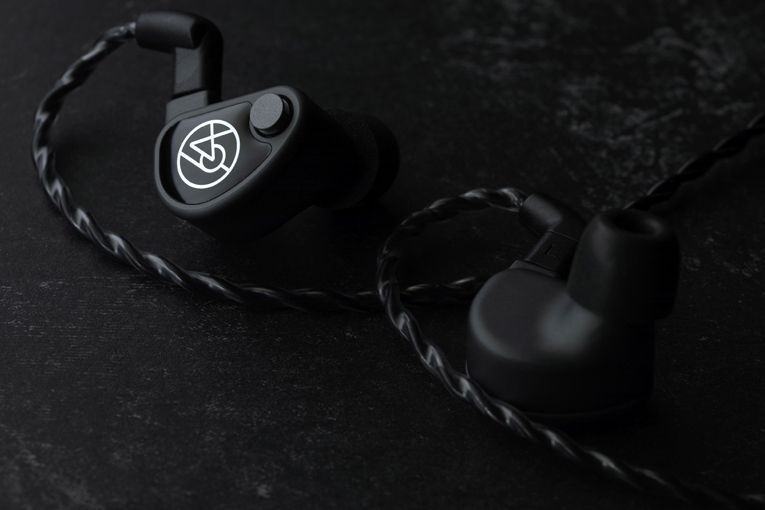Sound: 









Value: 









(Read about our ratings)
Measurements can be found by clicking this link.
 The 64 Audio U6t earphones really put today’s high-end audio scene in perspective—the company bills them as a “cost-effective” option, yet they’re priced at $1299 (all prices USD). Granted, these are complex earphones, with six balanced-armature drivers per earpiece, set into machined-aluminum chassis, but still, most people would be amazed if you told them you spent $1300 on earphones.
The 64 Audio U6t earphones really put today’s high-end audio scene in perspective—the company bills them as a “cost-effective” option, yet they’re priced at $1299 (all prices USD). Granted, these are complex earphones, with six balanced-armature drivers per earpiece, set into machined-aluminum chassis, but still, most people would be amazed if you told them you spent $1300 on earphones.
Often, high-end headphone makers will give their more affordable products a bassier tonal balance, and that’s just what 64 Audio says it did with the U6t earphones. The company describes them as “slightly set apart from 64 Audio’s other UIEM [universal in-ear monitor] models by offering a softer presentation of a mix.” I gave the nine-driver, $1699 Nio earphones a pretty glowing review, rating the sound an almost perfect 9.5 out of 10, so I expected that I might find the U6t’s a step down from the Nios in sound quality. But ya never know . . .

These earphones aren’t just little plastic blobs crammed full of balanced armatures—like the Nios, the U6t’s pack some serious engineering innovation. There’s the TIA (Tubeless In-Ear Audio) configuration, which positions the drivers so they vent into chambers rather than into individual tubes. This design also permits the enclosures on some of the armatures themselves to eschew the tiny sound-channeling tubes found in other balanced armatures. As the U6t earphones are a “budget” design—relatively speaking—they use a tubeless armature only for the high-frequency driver, which you can actually see behind the mesh that covers the sound tube. There’s also LID (Linear Impedance Design), which flattens out the impedance curve so the U6t’s don’t show the huge impedance swings with frequency seen in most balanced-armature earphones.
Last, and most visible to the user, is APEX (Air-Pressure Exchange)—interchangeable vents that plug into the sides of the earphones and are said to release internal pressure for increased user comfort and less isolation from outside sounds. The factory-installed M15 module is said to reduce outside sounds by 15dB, although it doesn’t specify at what frequency bands. There are also M20 (-20dB) and MX modules (no specification).

That’s a lot of fancy tech. I’d guess three-quarters of the products I’ve tested that include all sorts of complicated extra features—from headphones and speakers to beard trimmers (yep, I review those, too)—weren’t actually any better than, or in many cases even as good as, cheaper models. But then, I loved the Nios. So I’m confused as to what my biases might be here. Fortunately, if you’re wise enough not to put all your faith in my subjective impressions, we also have a full set of measurements you can access from the link at the top of the page. And my measurement gear can’t read press releases, so it can’t be influenced by them.
In the box
The U6t’s include a hardshell, leather-covered carrying case about the size and shape of a hockey puck. They also include nine sets of eartips: three sizes each of generic silicone tips, SpinFit silicone tips, and foam tips, so there’s a very good chance you’ll find a size and type that seals well for you. The tips are held by a very cool and useful plastic thingy with a 64 Audio logo on it, which fits neatly into the top of the carrying case. Plus there are the M20 and MX modules in a little snap-fit holder, a cleaning tool, and a nice set of 4′ (1.2m) braided cables tipped with a 3.5mm stereo plug on the source end and dual-pin connectors on the ends that attach to the earphones. You can find replacement cables on 64 Audio’s website, and they’re also available from aftermarket suppliers.
Use
My experience with the Nios saved me a lot of time with the U6t’s. I suspected that even given the generous assortment of eartips that 64 Audio provides, I wouldn’t find any big enough to fit my XXL-size ear canals—and I didn’t. But I knew that, as with the Nios, I could get a great fit with my aftermarket, XL-size SpinFit tips. I also suspected that I’d get at least good sound, and maybe the best sound, with the stock M15 APEX modules. So within just a couple of minutes, I had a perfect fit with a great seal and an obviously well-balanced sound—and with my fave SpinFit tips, the U6t’s were comfortable and the over-ear cable design kept them in place during my daily dog walks. Also, the thickness of the cable and its slick finish made it much less tangly than the skinnier cables included with the Nios and the Meze Rai Pentas.
I can’t find anything to complain about here, except that the case is too hard and bulky to fit comfortably in a jeans pocket, but of course, you can always get a slimmer case for a few bucks on Amazon.

OK, I do have one complaint: every time I had to bend down to pick up my arthritic Shih Tzu and lift her onto a high curb during her walks, the earphone cable got tangled in her leash. But 64 Audio told me there are true wireless adapters (such as this model from FiiO) that will accommodate the U6t earphones' 0.78mm dual-pin connectors. For those of us blessed with geriatric toy dogs who still need their daily walkies, this is a gift from heaven.
As with the Nios, the U6t earphones’ 10-ohm rated impedance didn’t present a problem for the internal amp in my Samsung Galaxy S10 phone—I got plenty of volume, and the amp didn’t seem strained—but I mostly used an AudioQuest DragonFly Cobalt DAC-headphone amp for testing these earphones, just to make sure they were getting enough juice.
Sound
After giving the U6t’s the same ten hours of break-in that I give all headphones and earphones, the first thing I heard was “Buddy’s Bounce,” the lead tune on Take2, my upcoming jazz album with saxophonist Ron Cyger. I know this recording backwards and forwards because I mixed it; I collaborated with Allan Tucker, the mastering engineer; and I’ve heard it on innumerable audio systems. (It should go up on streaming services around mid-August.) And after just a few bars, I breathed a sigh of relief and said, “Oh, yeah!” because I could tell the U6t’s had no major colorations, and with the M15 modules, they had a realistic balance of bass vs. midrange vs. treble.

John Mayer’s new tune “New Light” (Sob Rock, 24-bit/48kHz FLAC, Columbia/Qobuz) is a super-slick, kinda yacht-rock-ish mix that’s obviously intended to sound smooth rather than dazzling, and the U6t earphones definitely gave me that. No instrument stood out in the mix (except when it was supposed to, like in the guitar solo), and I couldn’t hear any coloration—not even in the elements of the tune that are the most difficult to reproduce, such as Mayer’s voice, the snare drum, and the electric bass. Other earphones I tried tended to add some edge to Mayer’s vocals (which at this point I think we all understand aren’t supposed to have any edge), to elevate the bass or exaggerate its punch, and to make the snare sound too dull or too snappy. I expect some audio enthusiasts would prefer a more exciting sound that accentuates certain frequency bands, and they’re welcome to listen to whatever they like best, but that’s not what John Mayer’s music sounds like.
That’s not to say the U6t earphones’ bottom end couldn’t kick when necessary. They didn’t elevate the insistent kick drum—I can’t tell whether it’s doubled with electric bass or augmented with a digital sample—on the Tom Tom Club’s “Time to Bounce” (The Good the Bad and the Funky, 16/44.1 FLAC, Nacional/Qobuz), yet the kick still sounded powerful, tight, precise, and natural (even though there might have been no actual kick drum and microphone involved). There are a lot of different sounds in this mix, spread out across the soundstage, and I loved the way the U6t’s presented them all precisely and, well, maybe not naturally, but in a way that seemed consistent with good stereo mixing practice. I heard everything, from the percussion instruments ticking away at far left and right, to Tina Weymouth’s multitracked, overdubbed vocals spreading across about half the soundstage, to the dancehall-style toasting jumping in and out, to the keyboard squiggles panning around and seemingly overhead (and no, it’s not an Atmos mix, but it sounded like one). Yet the sense of spaciousness wasn’t exaggerated, which it probably would have been with earphones that have boosted treble.

I listen often to Berlioz’s Harold in Italy, Op. 16, by the San Diego Symphony conducted by Yoav Talmi, with violist Rivka Golani and violinist Igor Gruppman (16/44.1 FLAC, Naxos/Qobuz), because it’s a great performance and a really good-sounding recording. The intense fourth movement, “Allegro Frenetico (Orgy of Brigands. Memories of Scenes Past),” is a tough test for earphones because it’s so dynamic, and if played at a realistic volume, can push them into distortion or at least make them sound thin. I was able to get the U6t earphones playing at a level that seemed about as loud as a real orchestra in a hall—up to eardrum-straining levels on the triple-forte passages—but the sound never distorted or thinned out. I didn’t notice coloration in any of the instruments, and I got probably as realistic a sense of concert-hall acoustics as I’ve heard from earphones. I think getting a more compelling sense of ambience would require switching to open-back headphones, or maybe having a really good Atmos mix of this same recording (not holding my breath on that one).
Comparison
I compared the U6t’s to the Nios, the Meze Rai Pentas ($1099), and the Sennheiser IE 300s ($299). Both 64 Audio models used the M15 modules, which I preferred overall.
On that old chestnut, Tracy Chapman’s “Fast Car” (Tracy Chapman, 16/44.1 FLAC, Elektra/Qobuz), the U6t’s delivered what sounded to me like the most balanced presentation. That’s impressive considering the very good earphones they were up against, but it doesn’t mean that the U6t’s will necessarily be the ones you like best. The Nios were similar, with punchier (although slightly exaggerated, I thought) bass, and also a mildly more recessed (or less forward) presentation of the vocals. The Rai Pentas tilted more toward the trebly side; their sound wasn’t as full and satisfying, but I expect audiophiles will prefer the more trebly sound because it gives the impression of greater detail. The Sennheisers are much less expensive, but sounded a lot like the U6t’s, although their lower treble sounded relatively coarse (something hard to avoid with dynamic drivers), and they had a little too much zip in the mid-treble, which made the snare drum sound too snappy and thin.
For a quick confirmation, and to reward myself with a moment or two of sheer bliss, I put on King Crimson’s “Waiting Man” (Beat, 256kbps MP3, EG Records), a mid- and treble-heavy recording with percolating gamelan patterns played on electronic drums, electric guitars, and a Chapman Stick. I definitely felt that the upper mids and treble were clearer and more present (i.e., somewhat elevated in level) relative to the Nios, which is the opposite of what the company claims, but oh well—much as I liked the Nios, the U6t’s are basically the same thing, but for me, a little better.
Conclusion
I can’t ever say with certainty that any reader will like a certain set of headphones or earphones. The best I can tell you is that I heard no sonic anomalies, my measurements revealed no noteworthy flaws, and I had no reservations about the ergonomics. The product in question may still have a somewhat (but never radically) different character from other products I’ve loved, though, and it’s up to you—by visiting CanJam or other audio shows, perhaps—to figure out what’s going to work best for you.

While you might prefer a more trebly (or more bassy) set of earphones, I couldn’t find anything I didn’t like about these. So they’re among only a few headphones or earphones to which I’ll award a 10 out of 10 in sound quality.
. . . Brent Butterworth
Associated Equipment
- Smartphone: Samsung Galaxy S10
- DAC-headphone amp: AudioQuest DragonFly Cobalt
64 Audio U6t Earphones
Price: $1299.
Warranty: One year.
64 Audio
4510 NE 68th Dr., Suite 102
Vancouver, WA 98661
Phone: (833) 642-8346
Website: www.64audio.com





